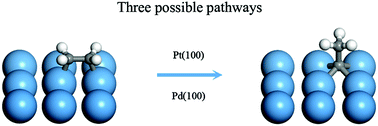Investigation on the conversion of ethylene to ethylidyne on Pt(100) and Pd(100) using density functional theory†
Abstract
The comprehensive formation network of ethylidyne (CH3C) from ethylene (CH2CH2) is investigated on Pt(100) and Pd(100) using the density functional theory method. The structural and energetic features of all intermediate products were considered. We found that the trend of the activation barriers in each pathway on Pt(100) and Pd(100) are the same, whereas the barriers on Pt(100) are higher than that on Pd(100). The activation barriers of 1,2-H shift reactions are relatively high compared with the other reactions. We screened three possible pathways and selected the optimal route as CH2CH2(ethylene) → CH2CH(vinyl) → CH2C(vinylidene) → CH3C(ethylidyne).


 Please wait while we load your content...
Please wait while we load your content...